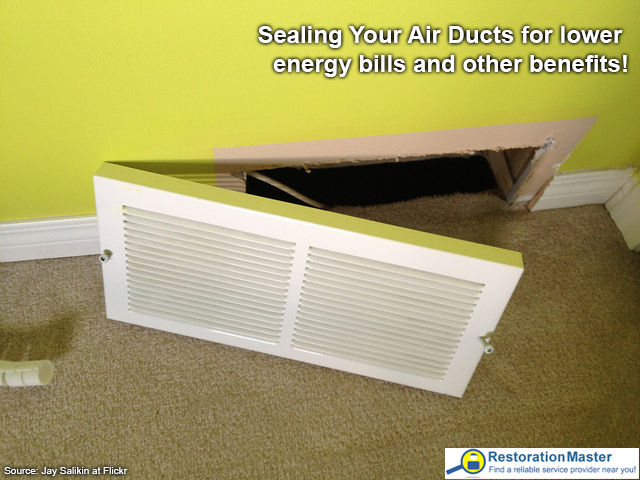How Poor Indoor Air Quality Can Affect your Health
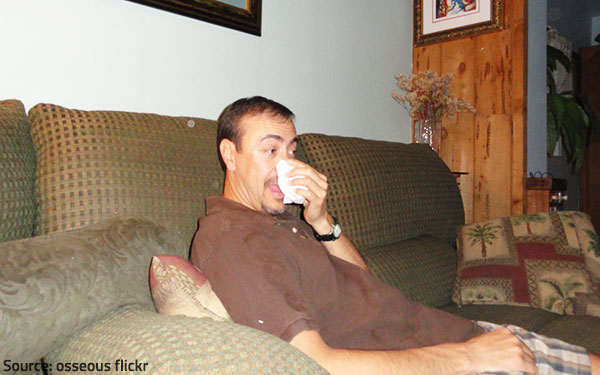
The air you are breathing in your home may be the reason you are not feeling well.
Your home is your fortress – your safe haven where you can take shelter and catch your breath after all the challenges, uncertainties, and risks you have encountered in the outside world. However, great dangers may be lurking in your home as well without you even realizing it – the very air you breathe, for example, may be threatening your health and compromising your well-being.
As a matter of fact, home air quality has recently become an important health and safety concern. It has been found that poor indoor air qualityIndoor air quality (IAQ) refers to the condition of the air ... More can cause or contribute to the development of various infections and chronic diseases, including asthma and lung cancer. Under certain circumstances, indoor air could be two to five times more polluted than the worst outdoor air and may have a very negative effect on your health. Naturally, people who spend a lot of time indoors, such as children and seniors, as well as chronically ill individuals, suffer the most from indoor air pollutionIndoor air pollution refers to the presence of harmful subst... More. The symptoms depend on the type of the contaminant that causes them and may vary considerably from one person to the next.
How Indoor Air Quality Affects Health
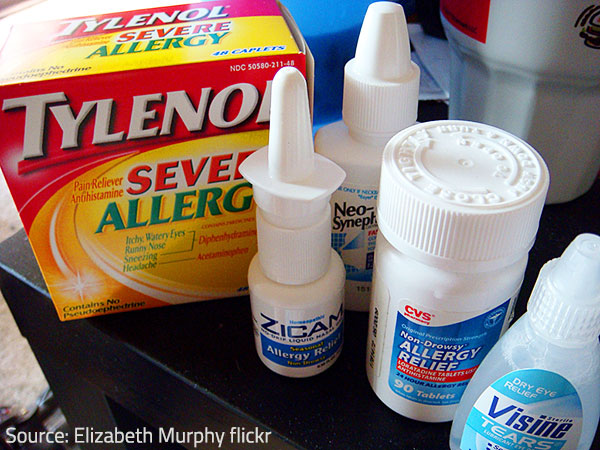
Allergy meds may become an integral part of your life if your living environment is not healthy and safe.
The effects of indoor air pollutants range from short-term symptoms that go away as soon as the affected person gets some fresh air to long-term health problems that result in serious diseases.
Common Symptoms of Indoor Air Pollution
The most common symptoms of poor indoor air qualityIndoor air quality (IAQ) refers to the condition of the air ... More can easily be mistaken for symptoms of other health problems such as allergies, stress, colds, or influenza. However, if they fade or disappear when you are away from a specific location, your symptoms are probably caused by indoor air contaminants. Exposure to polluted indoor air may result in:
- irritation of the eyes, nose, throat, and skin
- headaches
- coughing
- sneezing
- fatigue
- rashes
- dizziness
- shortness of breath
- hypersensitivity
- nasal congestion
Severe Symptoms of Indoor Air Pollution
Sometimes, very high levels of concentration of air contaminants or the presence of particularly harmful air pollutants in your home environment may have long-term effects and cause severe health problems:
- respiratory diseases and difficult or painful breathing
- rapid heartbeat and heart disease
- lethargy or malaise
- nausea, vomiting, or even anorexia
- worsening asthma
- lung cancer
Some people are more sensitive than others, so not all your family members or coworkers will be affected with the same symptoms or to the same extent. As air quality deteriorates and the length of exposure increases, however, more people are affected and the symptoms become more serious. So, immediate measures should be taken as soon as you begin to suspect that poor indoor air qualityIndoor air quality (IAQ) refers to the condition of the air ... More in your living/working environment poses health hazards to the occupants. In order to find an efficient solutionA solution is a homogeneous mixture of two or more substance... More to the problem, you need to know what causes indoor air qualityIndoor air quality (IAQ) refers to the condition of the air ... More deterioration and how to prevent it in the first place.
What Causes Indoor Air Pollution
Once you are familiar with the most common air contaminants and their health effects, you will get a clear idea of how important it is to find effective ways to control the sources of indoor air pollutants. The concentration of common indoor air contaminants may increase for a number of reasons:
Insufficient Ventilation
Without a doubt, the insufficient inflow of fresh air in your home or commercial building can dramatically affect indoor air qualityIndoor air quality (IAQ) refers to the condition of the air ... More. The concentration of dust mites and various other allergens in the air becomes very high, resulting in infections, allergic symptoms, and asthma attacks.
Air circulation is very important for removing indoor air contaminants and preventing the buildup of pollutants. So, make sure the premises in your property are regularly ventilated through windows and doors, as well as with the help of exhaust fans, whole house fans, etc.
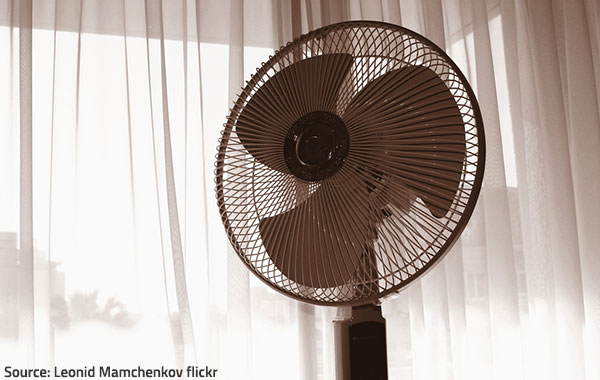
Let fresh air into your home and make sure air can circulate freely throughout the premises.
Occupants’ Activities
A number of everyday activities contribute to the contaminationContamination is the presence of harmful or unwanted substan... More of the air you are breathing in your home or workplace:
- Smoking – tobacco smoke is among the most common and most harmful indoor air pollutants. It contains over 200 known poisons including formaldehyde and carbon monoxide, as well as about 60 chemicals that can cause cancer. Secondhand tobacco smoke causes pneumonia, lower respiratory tract infections, asthma attacks and ear infections, not to mention heart diseases and lung cancer. The preventive measure against cigarette smoke in your home or office is quite simple – no smoking inside;
- Cleaning – many cleaning agents, solvents and disinfectants contain toxic vapors, harmful chemicals and volatile organic compounds that pollute the air and may provoke allergic symptoms (irritation of the eyes and the skin, headaches, dizziness, sneezing, coughing, etc.) or trigger asthma attacks. You need to wear personal protective gear (gloves, goggles) when cleaning with harsh chemicals and to air the premises thoroughly when you are done;
- Deodorizing and/or aromatizing – home deodorizers, as well as scented candles, incenses, deodorants, and other volatile substances also affect indoor air qualityIndoor air quality (IAQ) refers to the condition of the air ... More and aggravate the symptoms of people who suffer from allergic or respiratory conditions;
- Working with chemicals – pesticides, glues, paints, solvents and many other chemicals used in certain scopes of work pollute the air and result in health problems. Proper ventilationVentilation is the process of exchanging or circulating air ... More and adequate personal protection are of paramount importance in such conditions.
Combustion
Fuel burning appliances such as different kinds of stoves, water heaters, furnaces, fireplaces, etc. can release dangerous gases (mainly carbon monoxide and nitrous dioxide) if not properly installed and vented.
Carbon monoxide (CO) is a colorless and odorless poisonous gas produced when burning fuels, such as gas, oil, kerosene, wood, or charcoal. It can result in fatigue, headache, confusion, nausea, dizziness, and other similar symptoms. Prolonged exposure to high levels of CO can cause unconsciousness, long-term neurological disabilities, coma, cardiorespiratory failure, and even death.
Nitrous dioxide (NO2) is also very dangerous and difficult to detect as it has no color or specific odorAn odor is a smell, often detectable by the human nose, whic... More. It irritates the eyes, nose and throat, and may cause shortness of breath and frequent infections.
The risk of poisoning with CO or NO2 increases drastically during the winter period when the windows are tightly closed to keep the cold outside and the fuel burning appliances work at their maximum capacity. Make sure combustion appliances are properly installed and well maintained and allow enough fresh air inside even during the cold season to avoid health problems caused by dangerous combustion gases.
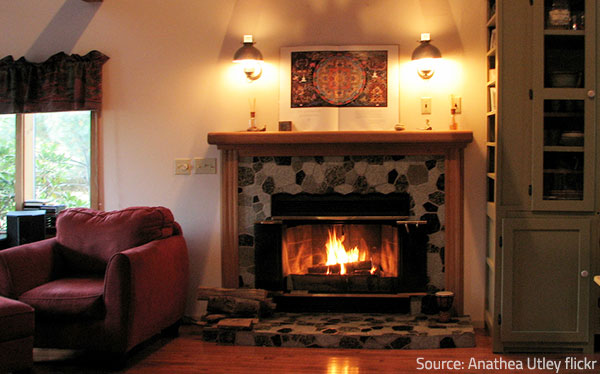
The playful flames bring joy and charm to the ambience but burning fuel may release dangerous gases in your home atmosphere.
Building Materials
Many building materials contain harmful substances that can threaten your health. Fiberglass, asbestos, and formaldehyde are just a few well-known examples.
Many asbestos products are found in the roofing and flooring materials of residential and commercial buildings, as well as in insulationInsulation is a material used in buildings to reduce the tra... More for ceilings, walls, pipes and heating equipment. Asbestos is a non-flammable mineral that can produce microscopic fibers. When inhaled, the fibers scar the lung tissue and may cause lung cancer. To avoid asbestos exposure, you are advised to cover source materials with an airtight seal.
Formaldehyde is a common chemical, found primarily in adhesive or bonding agents for various households materials, including carpets, upholstery, and plywood paneling. When released into the air, formaldehyde may cause coughing, irritation of the eyes and the nose, skin rashes, headaches, and dizziness. Formaldehyde products should be thoroughly aired on a regular basis to reduce the risk or completely avoided according to the contemporary safety standards.
Humidity
High temperature and humidityHumidity is the amount of moisture or water vapor present in... More levels can also increase the concentration of many pollutants. MoldMold is a type of fungus that grows in damp or humid conditi... More sporesSpores are microscopic reproductive units of fungi or mold t... More, various fungiFungi are a group of organisms, including mold, mildew, and ... More and bacteria thrive in moist places, so you need to control the moisture levels in your indoor surroundings. Use quality home dehumidifiers and fans, allow lots of fresh air inside to avoid condensation, fix any sources of excessive water in your property, remove stagnant water and make sure your home or business area is completely dry all the time. Otherwise, your risk frequent infections, aggravated allergic symptoms or asthma attacks.
Furnishings
Dust and debris get embedded deep into the fibers of many household fabrics such as carpets, upholstery and curtains. Dust mites and different organic vapors are powerful allergens that are easily carried by the airflow and can cause a number of allergic symptoms and health problems. Regular cleaning and fresh air can help you prevent dust and grit from building up.
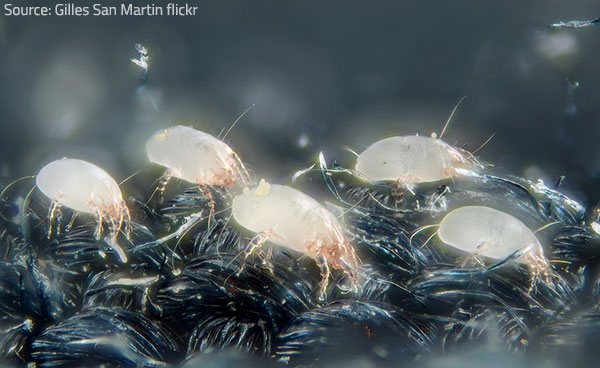
This is not a scene from a horror movie but the dust mites that develop in your home over time.
Biological Contaminants
Bacteria, virusesViruses are microscopic infectious agents that can only repr... More, animal dander, saliva, cockroach debris, and pollen buildup also affect the indoor air qualityIndoor air quality (IAQ) refers to the condition of the air ... More and often result in infections, allergy symptoms, and other health risks.
Some naturally occurring radioactive gases, such as radonRadon is a naturally occurring radioactive gas that can accu... More, can enter the home through cracks in the foundation floor or walls, drains, etc. and cause cancer or other severe health problems. Ozone (which is emitted from photocopiers, electric motors, electrostatic air cleaners and other similar devices) is another common indoor air pollutantA Pollutant is a substance that contaminates air, water, or ... More that can badly affect your health.
Nowadays, different innovative air quality testing methods allow you to check and monitor the air quality in your home or office. If you find out that your environment doesn’t meet the accepted indoor air quality standards, you should take timely and efficient measures to improve the situation and avoid serious diseases.
How to Improve IAQ in your Home
As already briefly mentioned, fresh air and low humidityHumidity is the amount of moisture or water vapor present in... More levels can help considerably improve the quality of the air in your home. However, these simple measures are usually not enough to reduce the amount of indoor air pollutants to the desired level. Taking into account the close interconnection between air quality and health, you may want to consider some more effective solutions:
- Air duct cleaning – a great amount of air pollutants accumulate in the air ducts, so their regular and thorough cleaning is of paramount importance for keeping the air in your home fresh and pure. The air filters throughout your home also play a crucial role in improving the indoor air qualityIndoor air quality (IAQ) refers to the condition of the air ... More – they trap various air pollutants and prevent them from entering your home “atmosphere”. To ensure their efficiency, however, you need to clean them on a regular basis and replace them whenever necessary. What’s more, any problems in the HVAC system should be fixed without delay as even seemingly minor issues may cause great troubles. If you are not up to any of these laborious tasks, you can always ask for professional assistance. Air duct cleaning specialists have appropriate equipment and rich experience, so their work will be quick and efficient and you’ll be able to enjoy the fresh air in your home without any hassle or efforts on your part;
- DehumidificationDehumidification is the process of reducing and controlling ... More – humid indoor environment allows various bacteria and air contaminants to thrive in your home and will inevitably result in moldMold is a type of fungus that grows in damp or humid conditi... More growth, sooner or later. You are recommended to open up the windows as often as you can, to run the bathroom fans every time you take a shower, to fix any leaking pipes or appliances at the earliest opportunity, and to use home dehumidifiers in order to control the humidityHumidity is the amount of moisture or water vapor present in... More level in your surroundings. If you are dealing with the aftermaths of water damage or if you are living in a very humid climate, you can hire professional dehumidificationDehumidification is the process of reducing and controlling ... More services to help you get rid of excessive moisture, condensation, etc.;
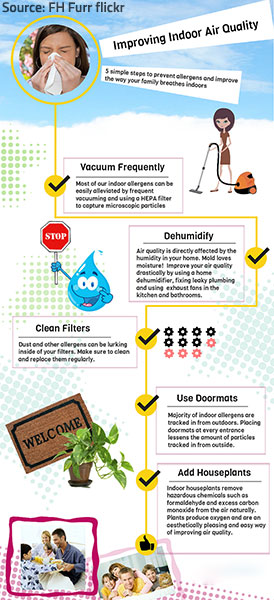
Learn how to improve the air quality in your home.
- Thorough cleaning – regular cleaning will help maintain a healthy living environment, of course, but it may not be enough to substantially improve the overall indoor air qualityIndoor air quality (IAQ) refers to the condition of the air ... More. Consider using professional cleaning services at least once or twice a year, especially when it comes to carpet and upholstery cleaning. Have in mind that removing all the dirt and dust embedded deep in the carpet fibers is very difficult without appropriate equipment. The professionals use effective cleaning products and carpet cleaning methods that yield astonishing results and help drastically reduce the amount of dust mites and other allergens in the air;
- Removing cigarette smoke and smell – the extremely small smoke particles can penetrate almost all household materials, so getting rid of cigarette smoke is quite difficult and time-consuming. Deep cleaning is required to remove the smoke residueSmoke residue is the fine, oily, or powdery particles left b... More from all the surfaces and materials in your home, so that you can then purify the air. Sometimes, the smoke particles are so deeply embedded in the furnishings and structural elements of your home that only professional smoke removal services can achieve the desired result. Smoke remediation specialists have extensive experience and use advanced equipment, such as ozone generators, hydroxyl technology, airs scrubbers, nano filters, etc. to help you get rid of cigarette smoke and enjoy healthy living conditions;
- Deodorization – removing musty odors, pet odorAn odor is a smell, often detectable by the human nose, whic... More and other offensive smells from your home will also help improve the indoor air qualityIndoor air quality (IAQ) refers to the condition of the air ... More. Call professionals if you want to take advantage of the above described efficient deodorizing and air cleaning techniques.
Have in mind that in addition to the other benefits of quick and efficient professional intervention in the event of a disaster, the competent technicians working in your home will also make sure that the air is clean and safe to breathe:
- Timely water damage mitigation and rapid dehumidification will prevent the development of moldMold is a type of fungus that grows in damp or humid conditi... More and other harmful bacteria inside your home;
- Mold remediation services will result in the safe containment and removal of moldMold is a type of fungus that grows in damp or humid conditi... More sporesSpores are microscopic reproductive units of fungi or mold t... More, so that the air in your home will be restored to a healthy state;
- Professional fire and smoke damage mitigation and restoration will guarantee that no sootSoot is fine black particles composed of carbon and other ma... More or smoke particles have remained to spread further damage to your property and contaminate the air.
If you are concerned about the air quality in your home, request professional indoor air consultation and ensure your well-being and your peace of mind.











